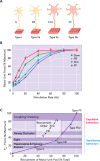Breathing: Motor Control of Diaphragm Muscle
- PMID: 29412056
- PMCID: PMC5899234
- DOI: 10.1152/physiol.00002.2018
Breathing: Motor Control of Diaphragm Muscle
Abstract
Breathing occurs without thought but is controlled by a complex neural network with a final output of phrenic motor neurons activating diaphragm muscle fibers (i.e., motor units). This review considers diaphragm motor unit organization and how they are controlled during breathing as well as during expulsive behaviors.
Figures



References
Publication types
MeSH terms
Grants and funding
LinkOut - more resources
Full Text Sources
Other Literature Sources

